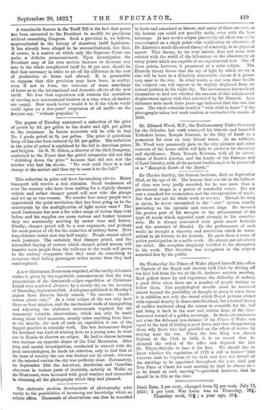The elaborate modern development of photography adds vastly to the
possibilities of increasing our knowledge which an eclipse offers. Thousands of observations can thus be recorded
in haste and examined at leisure, and many of them are such as the human eye could not possibly make, even with the best telescope. At last week's eclipse practically all effort was to be concentrated on a single point—the verification or otherwise of Dr. Einstein's much discussed theory of relativity, in its physical aspect. That theory, by its very nature, does not come into contact with the world of the laboratory or the observatory at many points which are capable of an experimental test. One of those point% however, is prominent at a solar eclipse. The Einstein theory shows that the ray of light by which we see a star will be bent to a definitely measurable extent if it passes very near to the sun. In other words, a star seen close beside the eclipsed sun will appear to be slightly displaced from its normal position in the night sky. The astronomers last week set themselves to find out whether the amount of this infinitesimal displacement agrees with that calculated by Dr. Einstein. Loss elaborate tests made three years ago indicated that this was the case. The whole scientific world is "with child to know" if the photographs taken last week confirm or contradict the results of 1919.


































 Previous page
Previous page